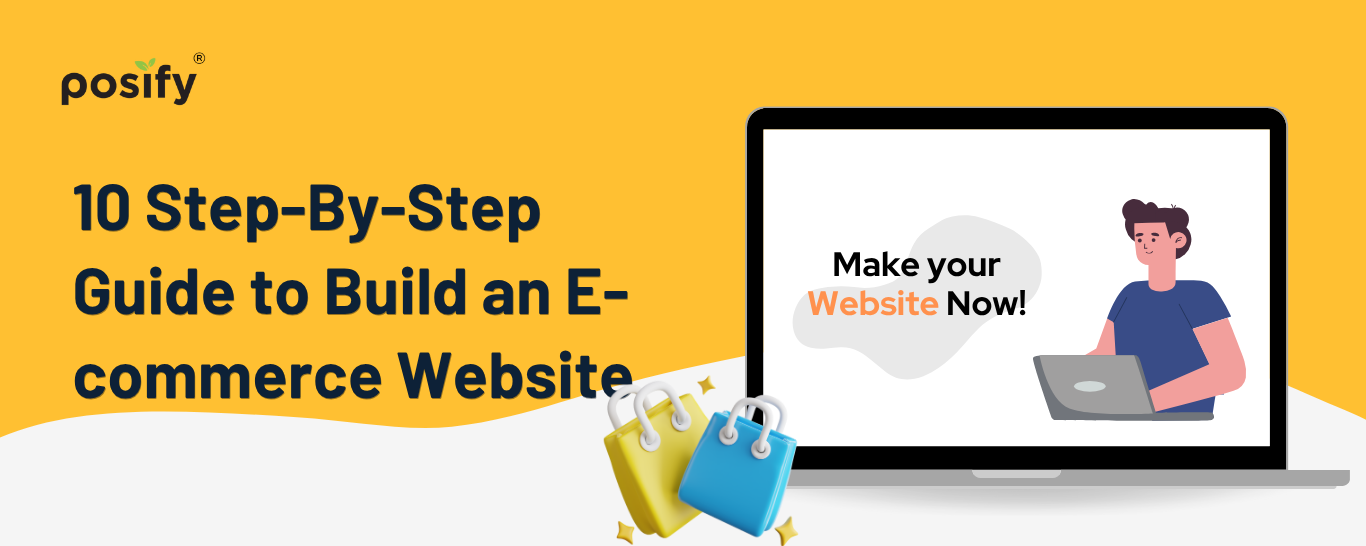10 Step-By-Step Guide to Build an E-commerce Website

In the digital era, launching an e-commerce website is no longer a luxury — it's a business necessity. Whether you're selling handmade crafts, digital products, or a full inventory of retail goods, building your own e-commerce site gives you control over your brand, customer experience, and revenue.
But where do you begin?
Here’s a simple, 10-step guide to help you build a successful e-commerce website — even if you’re not a tech expert.
Step 1: Define Your Niche & Business Model
Before you start any technical settings, you must first clarify your online store goals and core products. This is not only for designing website content, but also the key to ensuring the consistency of future operations.
Questions you need to answer include:
- What do I want to sell? (Product type and features)
- Who is my target customer group? (Age, spending power, interests)
- How do I differentiate myself from other brand online stores on the market?
- What is my pricing strategy?
- Why should customers choose me instead of other competitors?
This information will help you write product descriptions, design brand style, and even determine the page structure of the website in the future.

Step 2: Choose the Right E-commerce Platform
Choosing the right e-commerce platform is a crucial step in setting up your online store. It will directly affect your operational efficiency, website appearance, payment methods, and customer experience. Depending on your business model, budget, and technical skills, here are several common platform options:
1. Building Your Own Website
Building your own website is often the top choice for large or international brands, as it offers a high degree of freedom and full control over brand identity. These websites are typically created using open-source platforms or content management systems (CMS) such as WordPress with WooCommerce, Magento, or OpenCart.
The biggest advantage of this approach is its flexibility—you can fully customize the website’s design, functionality, and features to meet your needs. However, this also means a higher technical barrier. You’ll need to handle server hosting, website security, data backup, and ongoing maintenance—or hire a developer to help. Therefore, this method is best suited for well-resourced brands, teams with technical backgrounds, or businesses aiming for a fully controlled shopping experience.
2. Large E-commerce Marketplaces
While Hong Kong's local e-commerce landscape is not as diverse as that of Taiwan or Mainland China, there are still a few key platforms well-suited for merchants who want to quickly list products and reach a large number of potential customers. For example, HKTVmall is one of the most prominent local marketplaces in Hong Kong, known for its stable traffic, robust logistics support, and strong consumer trust.
For businesses looking to reach overseas customers, cross-border platforms like eBay, Etsy, and Amazon can also be good entry points. In a global city like Hong Kong, these platforms benefit from streamlined logistics and payment solutions. That said, while these marketplaces are easy to use and allow for quick market testing, merchants usually need to pay listing or commission fees. Moreover, customer data is limited, and brand visibility can be diluted by competing products on the same platform.
3. Website Builders (SaaS E-commerce Platforms)
For merchants without technical expertise who still want to build an independent branded website, SaaS-based e-commerce platforms are an ideal solution. These platforms offer ready-to-use online store services—just choose a template, set up your products and payment methods, and you’re ready to go. There’s no need to deal with server hosting or programming.
For most Hong Kong retailers, instead of handling the complex technical aspects themselves, it makes more sense to use an all-in-one e-commerce platform like Posify. Posify provides efficient and comprehensive store-building solutions tailored to different needs. Whether you're a first-time entrepreneur or an existing brick-and-mortar business looking to expand online, Posify offers professional support to help you succeed.

4. Social Media and Messaging Platforms
In a socially active city like Hong Kong, social media and instant messaging tools have become major sales channels for many SMEs and even solo entrepreneurs. Through Facebook Pages, Instagram accounts, and WhatsApp Business, merchants can communicate directly with customers, showcase products, provide instant responses, and even complete the entire shopping process.
This model is ideal for businesses that are just starting out, have a limited budget, or already possess a solid social media following. While it lacks the advanced analytics and automation features of traditional websites, it offers high interactivity and strong conversion rates, making it an increasingly essential part of modern e-commerce strategies.
Step 3: Design Website Structure and Pages
Once you've registered your domain and chosen your platform, the next step is designing your website's structure. The Information Architecture (IA) of your site significantly affects user experience and conversion rates.
When using the Posify platform, you can quickly design your site using pre-built templates and customize them according to your brand’s style—no coding required.
Tip: Assign clear SEO titles and descriptions for each category and product page, and incorporate relevant keywords to improve search engine visibility.
Step 4: Set Up Product Catalog and Inventory System
Uploading products is a key part of launching your online store. A complete, clear, and appealing product catalog enhances professionalism, improves SEO, and increases operational efficiency. Here's the core information you should prepare:
-
Product Name & SKU
Each product should have a clear name and a unique Stock Keeping Unit (SKU). The name should be concise and include searchable details such as brand, model, or color (e.g., “Classic Fit Men’s Jeans – Dark Blue”). SKUs help with inventory tracking and internal management. -
Pricing & Promotions
Set a retail price for each product, and consider configuring multi-tiered pricing strategies such as promotional pricing, limited-time offers, or member discounts. Clearly display both the original and discounted prices, and use strategies like “Free shipping on orders over $500” or “Add one more item, save $20” to encourage purchases. -
Inventory Quantity (Auto-Sync Recommended)
Effective inventory management is crucial. Your system should support real-time inventory syncing, automatically reducing stock when orders are placed. If you have offline stores or multiple sales channels, integrated inventory management is essential to synchronize stock across platforms and improve efficiency. -
Product Images & Videos
High-quality visuals significantly boost click-through and conversion rates. Provide 3–5 clear images per product, showcasing different angles and details. Short videos demonstrating product usage or styling are even better. Keep images consistent in style with clean backgrounds. -
Detailed Descriptions & Key Features (With Keywords)
Include basic specs (e.g., size, material, usage) and highlight unique selling points or use cases (e.g., “Perfect for daily office wear, breathable and wrinkle-resistant fabric”). Make sure to include relevant keywords (e.g., “summer short sleeves,” “in-stock in Hong Kong”) to improve SEO and attract organic traffic.
Step 5: Set Up Payment and Shipping Options
Your online store must offer convenient and secure payment and delivery options to build trust and boost conversions.
When setting up payment methods, pay attention to:
-
Convenience: Choose a payment gateway that integrates seamlessly with your platform (Shopify, Shopline, custom-built, etc.) for a smooth checkout experience.
-
Transaction Fees: Fees vary—some gateways charge per transaction, while others take a percentage of sales. Compare rates and terms to choose the most cost-effective solution.
-
Supported Payment Methods: Hong Kong shoppers use a wide range of methods—besides credit cards (Visa/Mastercard), PayMe, Octopus, Alipay, and WeChat Pay are increasingly popular. Make sure your gateway supports the main payment options for your target audience.
-
Multi-Currency Support: If you plan to sell internationally, choose a gateway that supports multiple currencies to minimize exchange rate issues and reduce friction for overseas buyers.
Logistics:
Efficient delivery systems ensure timely and secure product arrival, which is critical for customer satisfaction and brand credibility.
A well-designed logistics setup can reduce complaints from delays, damaged goods, or lost packages. Consider these key elements:
-
Choosing the right courier (e.g., SF Express for local delivery)
-
Store pickup options
-
International shipping (depending on your market)
With Posify, you can integrate multiple payment gateways and logistics providers, enabling auto-calculated shipping fees, order tracking, and a smoother checkout experience.

Step 6: SEO and Google Integration
Once your site is ready, you need to ensure customers can find it. That’s where SEO optimization comes in. Focus on:
-
Unique title tags and meta descriptions for every page
-
Natural inclusion of keywords like “online store,” “Hong Kong online shop,” “e-commerce,” etc., in product names and descriptions
-
Submitting a sitemap to Google Search Console
-
Installing Google Analytics and Facebook Pixel to track user behavior
Posify offers full SEO configuration for your store and product pages, helping you stand out in a competitive digital market.
Step 7: Member Management and Loyalty Program
In the e-commerce world, retaining existing customers is more valuable than acquiring new ones. A strong membership and loyalty system boosts repeat purchases and builds long-term brand value.
From member sign-ups, point tracking, and tiering to data analytics, Posify’s built-in system helps you save time, improve conversions, and strengthen customer relationships. The platform features an exclusive 3Rs loyalty strategy that aligns with the shopping lifecycle to grow a loyal customer base.
-
Recruit – Expand Your Member Base
Attract potential customers through sign-up rewards, first-purchase discounts, social media campaigns, and event registration. Posify supports flexible incentives like “Get a $50 coupon when you join” or “15% off your first order,” increasing sign-ups and engagement. -
Retain – Build Long-Term Engagement
Keep customers coming back through automated emails/WhatsApp messages, birthday greetings, personalized product recommendations, and shopping reminders. For example, send a check-in message after 30 days of inactivity, or offer VIP perks for high-value members. -
Reward – Encourage Repeat Purchases and Referrals
With a full points and tier system, customers can earn rewards for purchases, referrals, social shares, or event participation. Customize rewards like “1 point per $1 spent” or “Refer a friend and both get 300 points,” and let customers redeem points for coupons, gifts, or exclusive offers.
Posify’s member system helps you manage data, automate tier upgrades, and generate reports—enabling data-driven marketing strategies for better efficiency and ROI.
Step 8: Set Up Marketing Campaigns
Launching your store is only the beginning. The real challenge is attracting traffic and driving repeat purchases. Marketing is a core part of online store success—not just about running ads, but building brand awareness and engagement to drive conversions.
Effective strategies include:
-
Creating Facebook and Instagram brand pages
-
Running social media ads
-
Offering first-time buyer discounts
-
Launching limited-time deals or bundle promotions
Posify supports multiple marketing tools, including automated email campaigns, discount code management, and membership tiers to help you boost customer retention and grow revenue.
.png)
Step 9: Launch Your Store
After all the preparation, it’s time for the big step—going live. This isn’t just a matter of clicking "Publish." It’s the stage where you'll face real customers, real feedback, and your first orders.
Before launching, check the following:
-
Products can be added to cart and purchased without issues
-
All payment methods (e.g., credit cards, PayPal, FPS) work properly
-
The website looks consistent on mobile, tablet, and desktop
-
No typos, broken images, or dead links
-
Order confirmation and email notifications are sent correctly
-
Product pages have clear titles, descriptions, keywords, and images
-
Homepage showcases featured products, key categories, and brand identit
Step 10: Continuous Optimization and Data Tracking
An online store is never “done”—it's an ongoing optimization process. Use backend analytics and tools like Google Analytics to monitor:
-
Best-selling products
-
Traffic sources
-
Peak traffic hours
-
Pages with high bounce rates
These insights allow you to fine-tune your product offerings and marketing strategies, improving conversions and overall performance over time.
Conclusion: Make Starting an Online Store Easy with Posify
For Hong Kong retailers, opening an online store is no longer a high-barrier investment. With Posify, you can handle everything from domain registration, website design, inventory management, payment and logistics integration, to marketing—all in one platform, without hiring a tech team or paying high development fees.
👉 [Try Posify for Free Now] – Build your brand’s online store in just a few steps!





